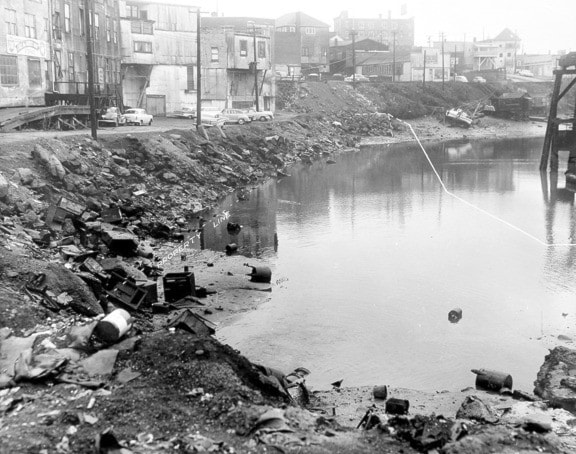The future of development in downtown Nanaimo will depend a lot on its past.
Downtown Nanaimo Business Improvement Association initiated a study on potential development along the Terminal Avenue-Nicol Street corridor by first investigating the likelihood of contaminated soil beneath the properties lining the roads.
The area – known as the Terminal Trench – was once a ravine running from the Pearson Bridge to Port Place shopping centre. It became the dumping ground for not only debris from coal mines, but garbage from the community and was eventually filled in.
Christine Meutzner, manager of the Nanaimo Community Archives, said the dumping began in 1891 and the ravine was filled by the early 1920s.
“They built a little railroad track out there and would dump, build some more track and dump, and build some more until eventually the whole thing was filled in,” she said. “It was used as a garbage dumping ground before they started to fill it. We have photos showing washing machines and unbelievable garbage in it, but I don’t know of anything toxic.”
But it’s the quality of the fill that is raising questions about the area.
Corry Hostetter, DNBIA general manager, said the idea of developing Terminal Avenue and Nicol Street was talked about for years, and the more information property owners have the better.
“Our planning, design and development committee identified some factors that have to be met before any potential development could happen,” she said. “We believe there are quite a number of property owners who want to develop or may want to sell their property and if remediation, or a remediation study is required, that could be quite expensive and a barrier to development.”
The Federation of Canadian Municipalities has up to $125,000 in grants to deal with contaminated sites and Hostetter hopes to receive funding to begin Phase 1 of the initiative.
Close to 60 property owners from Comox Road to Milton Street – representing nearly 100 sites – were invited to an information session to lay down the groundwork for the future.
“The first thing we want to do is collect information, make sure the property owners have it and can then decide what to do with it,” said Hostetter. “We can stay status quo or we can get the grant money to help us do something about it.”
The first phase includes gathering information on the environmental status of the area and an analysis of alternative traffic flow scenarios should remediation work commence.
Bruce Anderson, manager of community planning, said the city plans to participate in the process because it’s important to know what’s there.
“It’s a level of effort that is substantial. If you take the Terminal Avenue Trench, you have a series of property owners who would have to show some interest in looking collaboratively at a process to get the information and sort out what to do with it,” he said.
“It isn’t simply waving the wand and expecting everyone is going to want to invest significant amounts of time and money to see properties cleaned up. They need to know what’s in store for them.”
The trigger to driving the process toward an investigation is the desire for change.
“Many sites – gas stations are a good example – will sit for an awful long time because they’re known to have at least some expected level of contamination. But until the owner wants to do something with that property, they don’t typically engage in the process to get to that change point,” Anderson said. “The process is usually a series of investigations with increasing levels of testing. But it then hits a point where a property owner will question his options in dealing with the issues.”
Hostetter hopes to have the bulk of the information for Phase 1 back within a month and then formalize a report summarizing the findings and the strategies to move forward.
“Phase 2 is to define the action steps to overcome the challenges found in Phase 1 and implement them,” she said. “This project needs to seen all the way through to the end. I remember in 2006 when some architectural drawings showed what Terminal Avenue could look like and what it could potentially mean for property owners.
“It is the gateway into the downtown core and it would be great to see it developed into something beautiful.”
